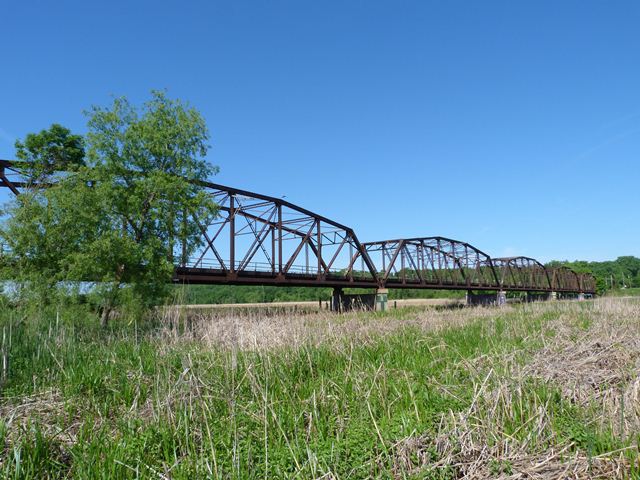We Recommend:
Bach Steel - Experts at historic truss bridge restoration.
BridgeHunter.com Phase 1 is released to the public! - Visit Now
Long Meadow Bridge
Old Cedar Avenue Bridge

Primary Photographer(s): Nathan Holth
Bridge Documented: June 3, 2013 and November 22, 2021
Bloomington: Hennepin County, Minnesota: United States
1920 By Builder/Contractor: Illinois Steel Bridge Company of Jacksonville, Illinois
2016
170.0 Feet (51.8 Meters)
864.5 Feet (263.5 Meters)
21 Feet (6.4 Meters)
5 Main Span(s)
3145

View Information About HSR Ratings
Bridge Documentation
Update To Below Narrative: This bridge was rehabilitated for pedestrian use in 2016.
View The National Register of Historic Places Nomination Form For This Historic Bridge
View A City Presentation From September 2013 About This Bridge

With its impressive five span design, this bridge is an outstanding example and relatively rare example of a multi-span truss bridge in Minnesota. It is additionally an uncommon example of a Camelback truss. The bridge retains good historic integrity with no major alterations to the truss being noted.

Above: Drone views of bridge following rehabilitation. Photo Credit: Mark Boetcher
This bridge carried traffic over Long Meadow Lake, and southeast of this bridge an older 1891 swing bridge carried traffic over the adjacent Minnesota River. This bridge carried vehicular traffic until 1993. Following 1993, it remained open to pedestrians until 2002 when it was closed to pedestrians as well. Since that time, the future of this bridge has been highly uncertain, with the historic bridge being at risk for demolition. The decision making for this bridge revolved around whether to preserve the historic bridge for pedestrian use or to demolish and replace with a non-historic pedestrian bridge. In the opinion of HistoricBridges.org, this decision making process was likely made more difficult due to hired consulting engineers who have claimed it will cost twice as much to rehabilitate the bridge as to replace it. Given that the bridge is not in that bad of a condition (the worst areas seem to be the deck and flooring system), and given that pedestrians do not weigh as much as the vehicles the bridge was originally designed to carry, this bridge should not be overly costly to rehabilitate or to maintain following rehabilitation. Had a consultant been hired with a much deeper experience in rehabilitation of historic metal truss bridges it may have been possible to trim the rehabilitation costs considerably, while at the same time not reducing the quality of the rehabilitation. Despite any difficulties with the hired consultants and estimated costs, as of September 2013,the city moved ahead with rehabilitation of this important historic bridge for vehicular use. Regardless of cost, this was an outstanding decision. Especially for pedestrian use, it is important to preserve historic bridges. For pedestrians, a historic bridge offers a more interesting and beautiful crossing than any ugly modern bridge would. Additionally, this bridge is a rare example of a surviving multi-span highway truss bridge in Minnesota.
![]()
Photo Galleries and Videos: Long Meadow Bridge
Bridge Photo-Documentation
Original / Full Size PhotosA collection of overview and detail photos. This gallery offers photos in the highest available resolution and file size in a touch-friendly popup viewer.
Alternatively, Browse Without Using Viewer
![]()
Bridge Photo-Documentation
Mobile Optimized PhotosA collection of overview and detail photos. This gallery features data-friendly, fast-loading photos in a touch-friendly popup viewer.
Alternatively, Browse Without Using Viewer
![]()
Maps and Links: Long Meadow Bridge
Coordinates (Latitude, Longitude):
Search For Additional Bridge Listings:
Bridgehunter.com: View listed bridges within 0.5 miles (0.8 kilometers) of this bridge.
Bridgehunter.com: View listed bridges within 10 miles (16 kilometers) of this bridge.
Additional Maps:
Google Streetview (If Available)
GeoHack (Additional Links and Coordinates)
Apple Maps (Via DuckDuckGo Search)
Apple Maps (Apple devices only)
Android: Open Location In Your Map or GPS App
Flickr Gallery (Find Nearby Photos)
Wikimedia Commons (Find Nearby Photos)
Directions Via Sygic For Android
Directions Via Sygic For iOS and Android Dolphin Browser
USGS National Map (United States Only)
Historical USGS Topo Maps (United States Only)
Historic Aerials (United States Only)
CalTopo Maps (United States Only)


